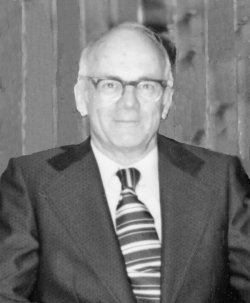Early Agricultural Health and Safety Work
For the first three decades, the program thrived under the leadership of Professor F.R. (Dick) Willsey who was recognized as a premier example of the traditional Extension education specialist. He traveled extensively promoting farm safety wherever he could gain an audience.

Professor F. R. (Dick) Willsey.
He was innovative in the use of safety plays and skits, audiovisual materials, demonstrations, and dynamic exhibits. Long before tractor rollovers became a national concern, he was conducting actual tractor overturn demonstrations to illustrate the high potential for death from this type of incident. When modern grain bins were first employed, he developed graphic displays demonstrating the hazards of flowing grain. In response to a lack of rural emergency medical services, he was active in promoting first aid training for farm families and later the organization of volunteer rural emergency medical units. His belief in the need for grassroots involvement led to a thirty-year involvement with the Indiana Farm Safety Council (
Indiana Rural Safety and Health Council), where he acted as a catalyst for a wide range of statewide rural safety and health efforts. Throughout his tenure as Extension Safety Specialist, he maintained a strong commitment to working with children and youth. He recognized early on that if attitudes and behavior were to change, they had to start with children. As a result, Purdue's Agricultural Safety and Health Program has always been heavily involved in promoting child safety and working with rural youth groups such as
4-H and
FFA.
Professor Willsey and other members of the Purdue staff were also involved with attempting to better understand the nature of agricultural injuries through ongoing applied research. The results of this research were used primarily for designing injury prevention programs and public awareness efforts. Early studies involved investigations of injuries associated with tractors, cornpickers, and other agricultural equipment and rural home-related injuries. The following is a partial listing of several of the early externally sponsored research projects conducted at Purdue.
- Purdue Farm Cardiac Project - 1964-1967.
Study of risks associated with returning to farm work following a heart attack.
Cooperators: Purdue University, Indiana Heart Association
- Accident Prevention by Control of Tractor Tipping - 1970-1972.
Study of tractor stability to reduce the frequency of overturns.
Cooperators: Purdue University, H.E.W.
- Investigation of Anhydrous Ammonia Accidents on Indiana Farms - 1972-1974.
Study of injuries resulting from exposure to agricultural anhydrous ammonia.
Cooperators: Purdue University, State Chemist Office, National Safety Council
- Develop and Field Testing of Agricultural Safety Education Materials - 1974-1976.
Preparation and field testing of safety materials to be used by agricultural workers, including migrant and seasonal workers.
Cooperators: Purdue University, U.S. D.O.L.
- Survey of Indiana Farm Accidents - 1965-1966, 1976-1977, and 1989-90.
Surveys of statewide farm accidents to determine the nature and magnitude of serious farm-related injuries.
Cooperators: Purdue University, National Safety Council, Indiana Extension Homemakers, Indiana Farm Safety Council, NIOSH
In 1977, William E. (Bill) Field replaced Professor Willsey who had retired the previous year.

Professor W. E. (Bill) Field
Building on the work started by Professor Willsey, Professor Field became heavily involved in coordinating and promoting local agricultural safety activities throughout the state. He sought to involve as many groups as possible in
program efforts including
Farm Bureau,
4-H,
FFA,
Extension Homemakers, insurance companies, implement dealers, and community organizations.
During the past three decades, under the leadership of Professor Field, Purdue's Agricultural Safety and Health Program has gained additional national and international recognition. Professor Field has developed both undergraduate classes and graduate programs that have exposed thousands of students to the field of agricultural safety and health. His coordination of graduate level research has resulted in the awarding of 35 graduate degrees in the field and dozens of research reports and published works that have contributed substantially to the literature available.
Last updated: 07-Dec-2011 3:17 PM




